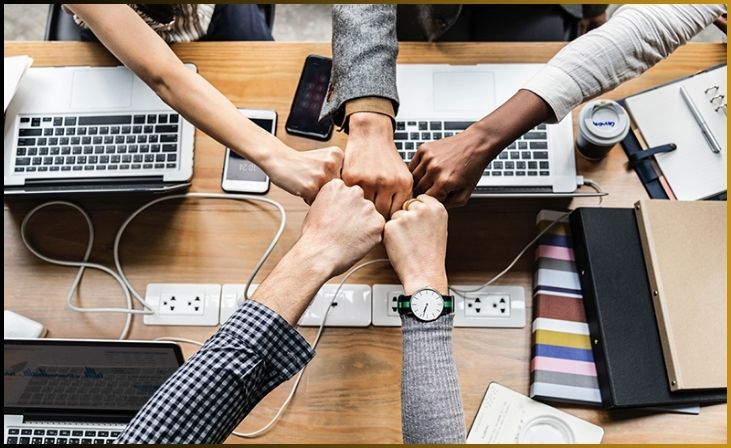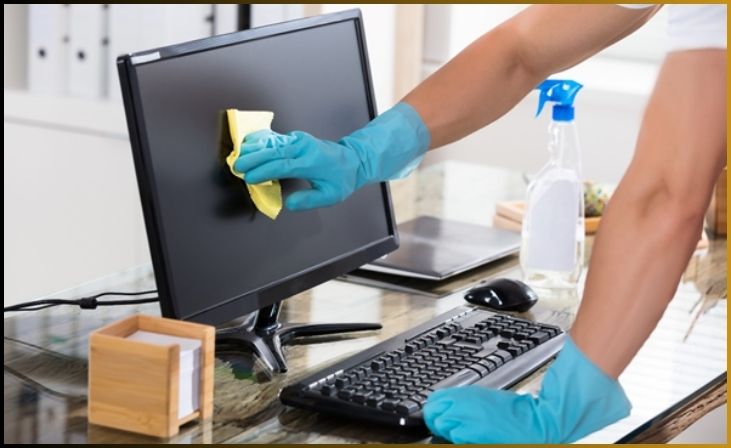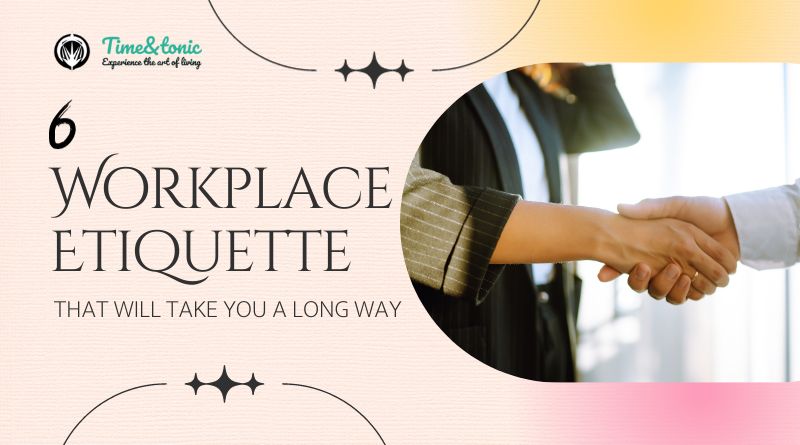6 Workplace Etiquette That Will Take You a Long Way
In today’s professional world, excelling in your career goes beyond just your skills and qualifications. Workplace etiquette plays a crucial role in building strong relationships, fostering a positive work environment, and advancing your career. In this article, we will explore six essential workplace etiquette that can take you a long way in your professional journey.
1. Professionalism

Punctuality and Reliability
Punctuality and reliability are fundamental aspects of professionalism that significantly influence your reputation in the workplace. Being punctual means arriving on time for meetings, appointments, and work-related commitments. It showcases your dedication, discipline, and respect for others’ time. When you consistently arrive on time, you demonstrate reliability, which is equally vital. Meeting deadlines and honoring your commitments builds trust among colleagues, superiors, and clients. It reflects your dependability and dedication to fulfilling your responsibilities consistently.
Dress for Success
Your choice of attire plays a crucial role in portraying professionalism. Your clothing and grooming habits convey a powerful message about your commitment to the organization’s values and expectations. Dressing appropriately for your workplace, whether it follows a formal dress code or encourages a more casual style, demonstrates your adaptability and respect for the company’s culture. Maintaining a well-groomed appearance shows that you take pride in your professional image and are mindful of representing the organization positively. By aligning your attire with workplace etiquette norms, you contribute to a cohesive and professional atmosphere.
Respectful Communication
Effective communication is a cornerstone of professionalism, and respectful communication is an essential component of it. Whether you are engaging in written or verbal communication, maintaining a respectful tone is crucial. Treating colleagues, superiors, and subordinates with courtesy and respect fosters a harmonious work environment. Avoiding offensive language, discriminatory remarks, or behaviors that could harm relationships is imperative. Respectful communication not only builds trust but also promotes open dialogue and collaboration. It creates a workplace etiquette where employees feel valued and included, contributing to a positive and productive atmosphere.
2. Effective Communication

Active Listening
Active listening is a foundational component of effective communication, and it plays a crucial role in establishing productive interactions with colleagues, superiors, and team members. This skill involves more than just hearing words; it encompasses the ability to engage attentively with the speaker and comprehend the message on multiple levels. Here’s an elaboration on active listening:
- Pay Close Attention: Active listening starts with giving your full attention to the person speaking. Minimize distractions, such as checking your phone or thinking about your response while they are talking. Maintain eye contact and use body language cues like nodding to convey your engagement.
- Ask Clarifying Questions: To ensure a clear understanding of the message, don’t hesitate to ask clarifying questions. Seek additional information or examples if something is unclear. This demonstrates your commitment to comprehending the topic and encourages open dialogue.
- Empathize and Show Interest: Actively listening also involves empathizing with the speaker’s perspective and showing genuine interest in what they are saying. This fosters a sense of respect and trust, making the speaker feel valued and understood.
Clarity and Conciseness
When it comes to expressing yourself effectively, clarity and conciseness are paramount. Here’s a more detailed explanation of these principles:
- Clarity: Clarity in communication means that your message is easily understood by the recipient. It requires organizing your thoughts logically and presenting them in a straightforward manner. Avoid ambiguity or vague language that might lead to misinterpretation. Provide context when necessary to ensure your message is clear.
- Conciseness: Being concise means delivering your message in a clear and succinct manner, without unnecessary elaboration or filler. Concise communication respects the recipient’s time and attention. It’s about getting to the point while retaining the essential information. Avoid jargon or technical terms that may confuse your audience, especially if they are not familiar with the terminology.
Quick Link: Top 5 Landscape Photography Gear
3. Collaboration and Teamwork

Be a Team Player
Being a team player is a fundamental aspect of collaboration and teamwork in the workplace. It goes beyond merely working alongside colleagues; it involves actively contributing to the team’s goals and fostering a cooperative spirit. Here’s an elaboration on this concept:
- Willingness to Collaborate: A team player is someone who is eager to collaborate with others. They don’t view their colleagues as competitors but as allies working towards a common objective. This willingness to cooperate creates a harmonious work environment where everyone’s strengths can be harnessed.
- Knowledge Sharing: Effective teamwork often requires sharing knowledge and expertise. Team players willingly share their insights, experiences, and skills to help the team succeed. This exchange of information not only benefits the immediate project but also enhances the collective knowledge base of the team.
- Offering Assistance: Team players are proactive in offering assistance when a colleague needs support. Whether it’s helping with a challenging task, providing guidance, or stepping in during a colleague’s absence, they contribute to the team’s overall productivity.
- Sharing Credit: Recognizing that success is a collective effort, team players are generous with sharing credit for accomplishments. They acknowledge and appreciate their colleagues’ contributions, fostering a positive team spirit built on trust and mutual respect.
Open-Mindedness
Open-mindedness is another key aspect of effective collaboration and teamwork. It creates an environment where diverse ideas and perspectives are welcomed and valued, ultimately leading to innovative solutions. Here’s a deeper look at the importance of open-mindedness:
- Embracing Diversity: Open-minded individuals appreciate the value of diversity in thought and perspective. They understand that a team comprising people with varied backgrounds and viewpoints can generate creative and well-rounded solutions.
- Encouraging Dialogue: Open-minded team members encourage open dialogue and discussion. They create a safe space where colleagues feel comfortable expressing their thoughts, even if they differ from the mainstream. This free exchange of ideas promotes a richer decision-making process.
- Exploring Innovation: Being receptive to new ideas and unconventional approaches allows teams to explore innovative solutions to challenges. Open-mindedness often leads to “out-of-the-box” thinking, which can give the team a competitive edge in problem-solving.
4. Respect for Differences

Embracing diversity and showing respect for differences is a fundamental aspect of fostering a harmonious and inclusive workplace. It involves acknowledging and appreciating the unique qualities, backgrounds, and perspectives that each team member brings to the table. Here’s a more detailed explanation of this workplace etiquette:
Cultural Sensitivity
In today’s interconnected and multicultural workplaces, cultural sensitivity plays a crucial role in promoting understanding and unity among colleagues. It involves the following elements:
- Awareness of Diversity: Being culturally sensitive starts with recognizing and appreciating the diversity of your colleagues. This includes understanding that individuals come from various cultural backgrounds, each with its own traditions, customs, and beliefs.
- Respect for Differences: Cultural sensitivity requires treating all colleagues with respect, regardless of their cultural background. This means avoiding stereotypes, biases, or discriminatory behaviors based on cultural differences. Instead, focus on valuing the richness that diversity brings to the workplace.
- Cultivating Cultural Competence: To truly embrace diversity, individuals can work on developing cultural competence. This involves actively seeking to understand different cultures, traditions, and customs. It may include learning about holidays, cultural practices, and communication norms to ensure respectful interactions.
- Inclusivity: A culturally sensitive workplace etiquette is inclusive, where all employees feel welcomed and valued, regardless of their cultural heritage. Inclusivity goes beyond tolerance; it means actively creating an environment where diversity is celebrated and leveraged to enhance teamwork and innovation.
Accepting Varied Opinions
In any collaborative setting, there will be differences in opinions, ideas, and approaches. Embracing diversity of thought and encouraging open dialogue is crucial for personal and professional growth. Here’s how accepting varied opinions contributes to a respectful workplace:
- Open Discussions: Embrace open discussions where colleagues are encouraged to express their opinions freely. Create a culture where diverse viewpoints are seen as assets rather than challenges. This open dialogue allows for a free exchange of ideas and fosters a deeper understanding of various perspectives.
- Constructive Criticism: Constructive criticism is an essential component of professional growth. Encourage colleagues to provide feedback and suggestions for improvement. When feedback is delivered in a constructive and respectful manner, it can lead to personal and team development.
- Well-Rounded Decisions: Different opinions often lead to more well-rounded decisions. When individuals with varying perspectives collaborate, they can identify potential strengths and weaknesses in proposed solutions. This collaborative problem-solving approach can result in more comprehensive and effective outcomes.
5. Conflict Resolution

Stay Calm and Collected
Conflicts can arise in any workplace due to differences in opinions, misunderstandings, or other factors. The key is to approach these conflicts with a composed and professional demeanor. Here’s a more detailed breakdown:
- Active Listening: When a conflict arises, take the time to actively listen to the concerns and perspectives of all parties involved. This means not interrupting or immediately defending your own position but genuinely trying to understand theirs.
- Avoid Heated Arguments: Heated arguments rarely lead to productive solutions. Instead, they tend to escalate the conflict further. Maintain your composure, even if the other party becomes emotional or confrontational.
- Avoid Personal Attacks: Keep the focus on the issues at hand rather than resorting to personal attacks or blame. Address the problem, not the person. Using “I” statements to express your feelings and concerns can be more effective than making accusations.
- Constructive Solutions: Work toward finding constructive and mutually beneficial solutions. This might involve brainstorming ideas, compromising, or finding common ground. The goal should be to resolve the conflict in a way that benefits everyone involved and promotes a positive working environment.
Seek Mediation If Needed
Sometimes conflicts can become too complex or emotionally charged for the parties involved to resolve on their own. In such cases, seeking external help, such as a neutral mediator or HR representative, can be a valuable step:
- Neutral Third Party: A mediator is a neutral third party who can help facilitate discussions between the conflicting parties. They don’t take sides but instead, assist in finding common ground and guiding the conversation toward resolution.
- HR Involvement: In some organizations, the Human Resources department plays a role in conflict resolution. HR professionals are trained to handle workplace disputes and can offer guidance and support in finding a fair resolution.
- Confidentiality: Mediation and HR involvement often come with a degree of confidentiality, which can make employees feel more comfortable discussing sensitive issues.
- Document the Process: It’s important to document the steps taken to resolve the conflict, especially if HR is involved. This helps maintain transparency and accountability throughout the resolution process.
You May Also Like: The 8 Most Stunning Peacocks in the World
6. Workplace Hygiene and Etiquette

Hygiene and Cleanliness
a. Workspace Organization: Maintaining a clean and organized workspace is not only a matter of personal comfort but also reflects professionalism. Here’s how to do it:
- Regularly clean and disinfect your desk, keyboard, mouse, and other frequently touched surfaces.
- Keep your documents and belongings neatly arranged rather than scattered around.
- Avoid accumulating unnecessary clutter on your desk or in shared spaces.
b. Dispose of Trash: Proper disposal of trash is essential for cleanliness and hygiene:
- Use designated trash bins for disposing of waste.
- Ensure that you don’t leave food wrappers, used tissues, or other garbage lying around.
c. Tidy Common Areas: Shared spaces, such as kitchenettes, meeting rooms, and restrooms, should also be maintained:
- Clean up after using common areas, including washing dishes and utensils if you use them in the kitchen.
- Report any maintenance issues or cleanliness concerns to the appropriate authority or facilities management.
Considerate Behavior
a. Noise Control: Noise levels in the workplace etiquette can significantly impact productivity and well-being. To be considerate:
- Keep phone conversations at a reasonable volume, and consider using headphones or private meeting spaces for calls.
- If you listen to music or audio, use headphones to avoid disturbing others.
- Avoid loud or disruptive behavior that can distract colleagues.
b. Food Etiquette: Food-related habits can have a significant impact on the workplace environment:
- Avoid strong-smelling or pungent foods at your desk, as these odors can be unpleasant for others.
- Use designated areas, like the kitchen or breakroom, for eating, and clean up any spills or crumbs promptly.
- Respect any food-related policies or guidelines set by your workplace.
c. Phone Etiquette: When using your phone in the office:
- Set your phone to vibrate or silent mode during meetings or work hours.
- Speak quietly when on the phone, especially in open office spaces.
- Be mindful of speakerphone usage, as it can disturb others nearby.
d. Respect Personal Space: Give your colleagues the space they need to work comfortably:
- Avoid leaning over or invading someone else’s workspace without permission.
- Respect boundaries and the need for privacy.
Conclusion
In the world of work, mastering workplace etiquette is a valuable asset that can propel your career forward. These six workplace etiquettes, from effective communication to showing appreciation, serve as a guide to creating a positive and productive work environment. By practicing these etiquette principles, you not only gain the respect of your colleagues but also enhance your professional reputation. Remember, in the journey of your career, it’s not just about what you know but also about how you conduct yourself in the workplace.
FAQs
Workplace etiquette is essential as it helps establish a harmonious and respectful atmosphere in the workplace. It improves communication, reduces conflicts, and enhances teamwork. Adhering to etiquette norms also reflects positively on your professionalism.
To improve workplace communication etiquette, focus on active listening, choose your words carefully, and be mindful of your non-verbal cues. Encourage open and respectful dialogues, and seek clarification when needed. Practicing effective communication fosters better relationships with colleagues.
Yes, workplace etiquette remains important in remote or virtual work settings. While the dynamics may be different, showing respect, professionalism, and courtesy to colleagues through virtual communication, emails, and video conferencing is crucial for maintaining positive working relationships and productivity.




